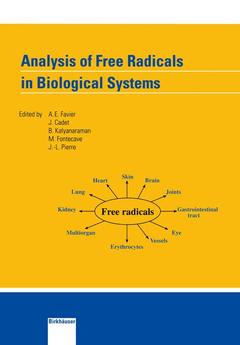Analysis of Free Radicals in Biological Systems, 1995
Langue : Français
Coordonnateurs : Favier A., Cadet J., Kalyanaraman B., Fontecave M., Pierre J.L.

"Oxidative stress" is used as the generic term describing the involve ment of reactive oxygen species in various human diseases. The scope of such a topic is becoming increasingly wide. The recent interest in radicals such as nitric oxide and the discovery of new mechanisms such as the effect of free radicals on redox sensitive proteins and genes are enlarging our understanding of the physiological role of free radicals. Oxidative stress is involved in numerous pathological. processes such as ageing, respiratory or cardiovascular diseases, cancer, neurological pathologies such as dementia or Parkinson's disease. It still remains difficult, however, to demonstrate by chemical measurement the in vivo production of free radicals and even more to realise their speciation. Therefore, the development of new tools and indicators is engrossing many researchers working in this field. Reliable indicators are abso lutely necessary not only to monitor the evolution of oxidative stress in patients but also to evaluate the efficiency of new antioxidant treat ments. The French Free radical club of Grenoble, the CERLIB has been involved for many years in the organisation of international training programs on methodology, in order to provide both theoretical and practical help to researchers from various countries. Such training sessions have been highly successful and participants value the oppor tunity to learn reliable techniques. This positive echo explains why the researchers of CERLIB decided, with the help of Prof. Dr. B. Kalyanaraman, to publish selected techniques on free radical re search.
Mechanisms of oxidative stress.- Chemistry of dioxygen and its activated species.- Biological sources of reduced oxygen species.- Nitric oxide: Chemistry and biology.- Pro-oxidant and antioxidant effects of nitric oxide.- Oxidative damage to DNA.- Oxidation of low density lipoprotein (LDL) by cells.- Oxidative stress in clinical situation.- Free radicals and antioxidants in human diseases.- How to demonstrate the occurrence of an oxidative stress in human?.- New developments in ESP and spin-trapping.- EPR evidence of generation of superoxide anion radicals (O2·-) by irradiation of a PDT photosensitizer: Hypericin.- Nitrone spin traps as reagents for the study of oxidative modification of low density lipoproteins: Implications for atherosclerosis.- Ascorbate radical: A valuable marker of oxidative stress.- Determination of lipid peroxidation-derivated products.- Lipid hydroperoxide analysis by reverse-phase high-performance liquid chromatography with mercury cathode electrochemical detection.- Determination of primary and secondary lipid peroxidation products: Plasma lipid hydroperoxides and thiobarbituric acid reactive substances.- Measurement of low-density lipoprotein oxidation.- Evaluation of DNA damages.- Determination of 8-oxo-purines in DNA by HPLC using amperometric detection.- Measurement of one of the features of apoptosis: DNA fragmentation.- Measurement of plasma sulfhydryl and carbonyl groups as a possible indicator of protein oxidation.- Measurement of oxidized nucleobases and nucleosides in human urine by using a GC/MS assay in the selective ion monitoring mode.- Miscellaneous techniques.- Methodological and practical aspects for in vitro studies of oxidative stress on cell culture models (toxicity and protection).- Detection and production of nitricoxide.- Salicylate hydroxylation products assay as a marker of oxidative stress in man: A sensitive HPLC-electrochemical method.
The main aim of the book is to provide a comprehensive survey on recent methodological aspects of the measurement of damage within cellular targets. The central part of the book is devoted to the description of selected methods aimed at monitoring the production of free radicals in cellular systems. In addition, several assays are provided to assess the chemical damage induced by reactive oxygen species in critical cellular-targets in vitro and in humans in vivo. One of the major features of the book is the description of new experimental methods. These include the measurement of oxydized DNA bases and nucleosides, new techniques for the determination of LDL oxidation using spin-trap agents, and the use of salicylate as an indicator of oxidative stress. The book will serve a large scientif
Date de parution : 04-2014
Ouvrage de 312 p.
17x24.4 cm
Thème d’Analysis of Free Radicals in Biological Systems :
Mots-clés :
DNA; Lipid; Oxidation; Purine; Termination; apoptosis; biochemistry; biology; cell; cell biology; cell culture; chemistry; oxidative stress; protein; proteins
© 2024 LAVOISIER S.A.S.



